(Posted 18 May 2016) This Sunday (22 May 2016) is going to be a busy one for casual sky watchers on the Gold Coast (Queensland, Australia)! The International Space Station is going to pass directly overhead and the planet Mars will reach opposition on the same night. As an added bonus , the two giants of the Solar System Jupiter and Saturn will also be easy to spot using just your unaided eye.
Firstly to the Space Station. It will be briefly visible as a moderately bright star rising in the South West at 6.30 pm. It will get brighter as it rises in the sky passing the star Canopus at 6.33 pm (see below finder chart). Just after 6.34 pm (and as it reaches almost directly overhead), the Space Station will fade from view as it moves into the Earth’s shadow. If you have binoculars, follow it with those and you will see the changing light of sunset reflecting off it just before it disappears into the darkness of night in space.
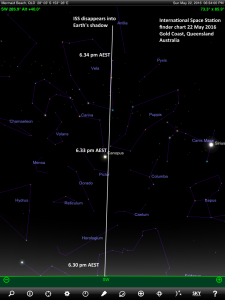
In spite of the International Space Station’s really large size (109 m by 51 m), it will only look like a bright star to the unaided eye. While you watch it move up from the horizon, keep in mind that it is travelling at approximately 27,000 kilometers per hours at a height of 400 km.
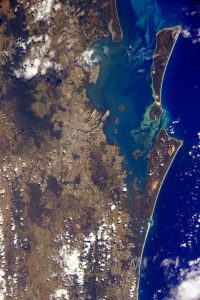
For the lucky six astronauts living on board the International Space Station, they get a completely different view of the Earth. The above picture taken by NASA astronaut Kjell Lindgren in September 2015 shows an amazing view of the Northern Gold Coast and Brisbane as seen from the International Space Station.
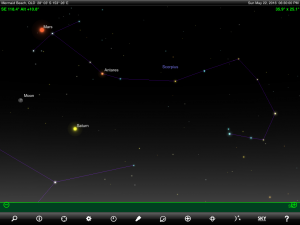
The other predictable highlight for Sunday night will be Mars reaching opposition. This is an astronomical term which refers to the time of the year where Mars is directly opposite the Sun in the sky. This means on Sunday, Mars will rise as the Sun sets and rise the following morning as the Sun rises. Usually this also coincides with a superior planets closest approach to the Earth for the year. Mars egg shaped orbit however means that its closest approach to the Earth will occur on May 31 at a distance of 75.279 million kilometers.
By coincidence, the Moon will be located below Mars on Sunday night. This means you can use the Moon as a celestial signpost to find Mars. Once the sky is relatively dark, just find the Moon and look up. Mars will be the bright reddish coloured star above the Moon. As an aside, Saturn is the pale yellow star located to the right of and below the Moon. Note that the brightness of the Moon will somewhat diminish the apparent brightness of Mars. Try looking at Mars in the following few nights and you will discover how bright it really is.
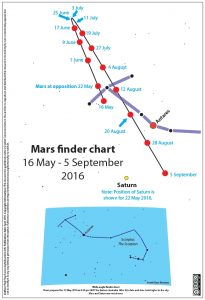
After opposition, Mars will continue to be visible in the Gold Coast evening sky. If you keep an eye on it over the next few months, you will notice that its location dramatically changes in the sky. This is caused by the Earth’s quicker orbital speed ‘leaving’ Mars behind (think of the Earth as the faster of two racing cars racing around the Sun).
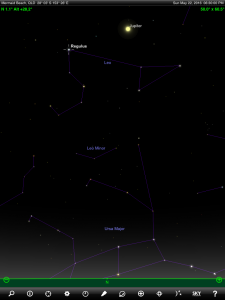
Jupiter is easy to locate in the Northern sky. Just look for the brightest star. If you happen to own a pair of binoculars or a small telescope, point them towards Jupiter and you will see the below view of its four largest moons. Saturn’s rings will also easily visible in a small telescope.

.
Gold Coast sky watchers! Look up Sunday night. Mars at opposition and Space Station to zip overhead. https://t.co/oX92UIDORU